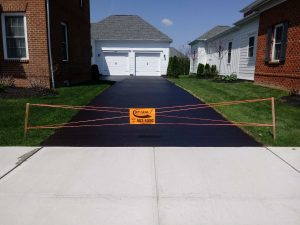Revitalize Angle Parking Lots: Asphalt Sealing Methods Exposed
Revitalize Angle Parking Lots: Asphalt Sealing Methods Exposed
Blog Article
Cold Mix Asphalt Vs. Hot Mix Asphalt: Which Is Right for You?

Make-up Differences
Cold mix and hot mix asphalts differ considerably in their make-up, with unique characteristics that affect their performance and applications. Cold mix asphalt is created by emulsifying the asphalt binder with water and an emulsifying agent before mixing it with accumulation. This approach permits the asphalt to be convenient at lower temperature levels, making it optimal for temporary fixings and for use in cooler weather problems. Hot mix asphalt, on the various other hand, is produced at high temperatures, commonly between 300-350 ° F, which assists to attain far better compaction and a more sturdy last product. The hot mix asphalt manufacturing procedure entails heating the accumulation and asphalt binder individually prior to combining them at the asphalt plant.
Furthermore, chilly mix asphalt has a tendency to be less dense and a lot more versatile than hot mix asphalt. This versatility makes it far better suited for areas with higher degrees of motion, such as driveways or roads with rush hour. On the other hand, hot mix asphalt is recognized for its high toughness and resistance to rutting and splitting, making it a favored choice for freeways and high-traffic roads where long life is vital.
Installment Refine Differences
The process of installing cool mix and hot mix asphalt displays notable differences in their treatments and requirements. In comparison, warm mix asphalt necessitates a more elaborate setup process. Due to the home heating needs, warm mix asphalt setups are normally carried out by experts with specialized tools, making certain a much more structurally sound and permanent outcome.
Longevity and Durability Factors
When considering asphalt choices, durability and longevity are essential aspects to review for lasting pavement performance. Hot mix asphalt (HMA) is recognized for its phenomenal toughness and long life. The high temperatures during the laying and blending process enable much better compaction, causing a denser and more powerful sidewalk structure. This results in HMA being more resistant to rush hour tons, harsh climate condition, and the results of maturing compared to cold mix asphalt (CMA)
In regards to longevity, HMA generally outperforms CMA as a result of its exceptional strength and resistance properties. HMA pavements have a longer life span, calling for less frequent repair work and maintenance, which can equate to cost financial savings over time. Furthermore, HMA pavements are much more conveniently adjustable to fulfill particular task demands, better improving their sturdiness.
Expense Considerations
Considering the financial ramifications is an important aspect when assessing the option in between warm mix asphalt (HMA) and chilly mix asphalt (CMA) for sidewalk jobs. While the preliminary cost of hot mix asphalt is usually greater than that of chilly mix asphalt, HMA typically supplies an extra cost-effective remedy in the lengthy run due to its superior sturdiness and long life.
In addition to product expenses, it's vital to think about the expenditures connected with installment and upkeep when contrasting HMA and CMA. Inevitably, the decision click for more between HMA and CMA read here must take right into account not simply the initial price yet additionally the long-term monetary effects to establish the most cost-effective option for the details pavement job.
Environmental Effect Contrast
Contrast of the ecological effects between hot mix asphalt (HMA) and chilly mix asphalt (CMA) reveals unique distinctions in sustainability techniques. HMA production needs high temperatures, leading to increased power usage and greenhouse gas exhausts.
In addition, the use of CMA commonly involves recycling existing asphalt pavement, advertising source conservation and lowering the quantity of waste sent to garbage dumps. By deciding for CMA over HMA, roadway building and construction jobs can contribute positively to environmental preservation initiatives.
Conclusion
Finally, the choice in between cool mix asphalt (CMA) and warm mix asphalt (HMA) depends upon various variables such as make-up, installment process, resilience, durability, expense, and environmental impact. cold mix asphalt. While CMA uses a economical and quick remedy for small repairs, HMA makes sure superior durability and durability for hefty traffic locations. Take into consideration these elements carefully to identify which sort of asphalt is the best choice for your paving requires

Considering the monetary implications is a critical element when examining the selection between hot mix asphalt (HMA) and cold mix asphalt (CMA) for pavement projects. While the first price of hot mix asphalt is typically higher than that of cool mix asphalt, HMA frequently provides a more affordable option in the lengthy run due to its remarkable durability and durability. cold mix asphalt.Comparison of the ecological impacts between hot mix asphalt (HMA) and cold mix asphalt (CMA) exposes distinct distinctions in sustainability techniques.In final thought, the web selection between cold mix asphalt (CMA) and warm mix asphalt (HMA) depends on various factors such as make-up, installment process, sturdiness, long life, cost, and ecological effect
Report this page